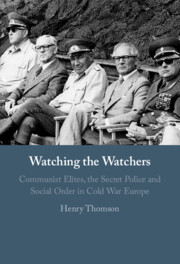Book contents
- Frontmatter
- Dedication
- Contents
- Figures
- Tables
- Acknowledgments
- Part I Introduction and Theory
- 1 Introduction
- 2 A Theory of Elite Cohesion, Coercive Capacity, and Authoritarian Social Order
- Part II Comparative Historical Analysis: Polish People’s Republic and the German Democratic Republic
- Part III Cross-national Quantitative Analysis
- Part IV Conclusion
- Appendix A Secret Police Agencies and Chiefs in Socialist Central and Eastern Europe, 1945–1989
- Appendix B Survival Analysis, Chapter 7
- Appendix C Agency Size Analysis, Chapter 8
- Bibliography
- Index
2 - A Theory of Elite Cohesion, Coercive Capacity, and Authoritarian Social Order
from Part I - Introduction and Theory
Published online by Cambridge University Press: 22 February 2024
- Frontmatter
- Dedication
- Contents
- Figures
- Tables
- Acknowledgments
- Part I Introduction and Theory
- 1 Introduction
- 2 A Theory of Elite Cohesion, Coercive Capacity, and Authoritarian Social Order
- Part II Comparative Historical Analysis: Polish People’s Republic and the German Democratic Republic
- Part III Cross-national Quantitative Analysis
- Part IV Conclusion
- Appendix A Secret Police Agencies and Chiefs in Socialist Central and Eastern Europe, 1945–1989
- Appendix B Survival Analysis, Chapter 7
- Appendix C Agency Size Analysis, Chapter 8
- Bibliography
- Index
Summary
This chapter lays out a novel theory of elite cohesion, coercive capacity, and authoritarian social order. Enabling and controlling coercive agents is a fundamental challenge confronting all dictators. Actors like secret police chiefs pose a grave threat to incumbent authoritarian elites because they hold the means of violence and could use them to overthrow their masters. Elites’ task of monitoring and controlling their coercive agents is a collective action problem. All members of an authoritarian ruling coalition are better off if they cooperate to control coercive agents. However, individual authoritarian elites have incentives to defect from cooperation. When authoritarian elites cannot cooperate to prevent insubordination by coercive agents, they reduce coercive capacity. Institutions promote authoritarian elite cohesion. They provide structures of shared expectations or focal points that allow authoritarian elites to pool their resources, cooperate, and control coercive agents. In Cold War communist Central and Eastern Europe, Stalinism was the institutional structure that promoted elite cohesion and led to the construction of large, capable coercive institutions across the region.
Keywords
- Type
- Chapter
- Information
- Watching the WatchersCommunist Elites, the Secret Police and Social Order in Cold War Europe, pp. 45 - 90Publisher: Cambridge University PressPrint publication year: 2024



